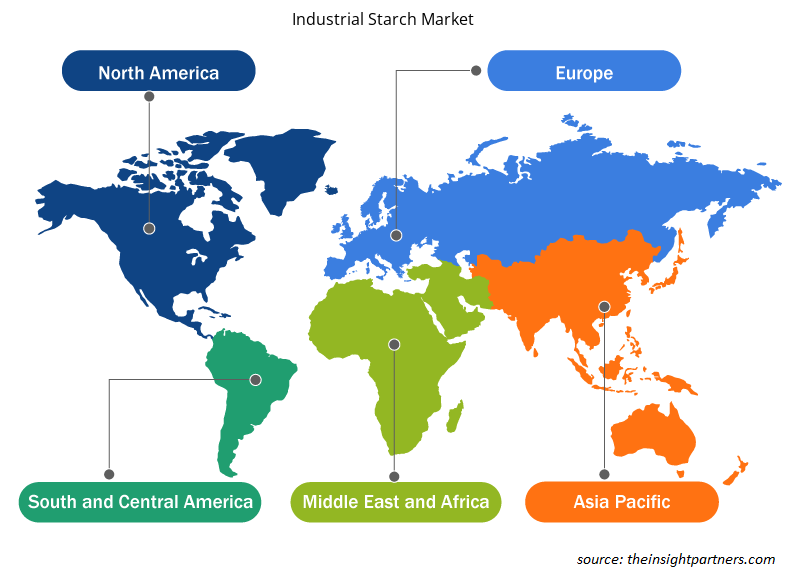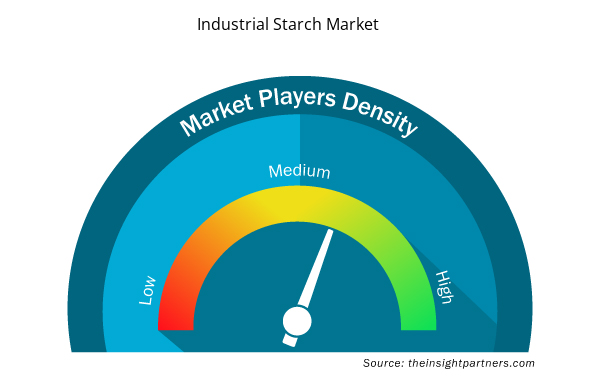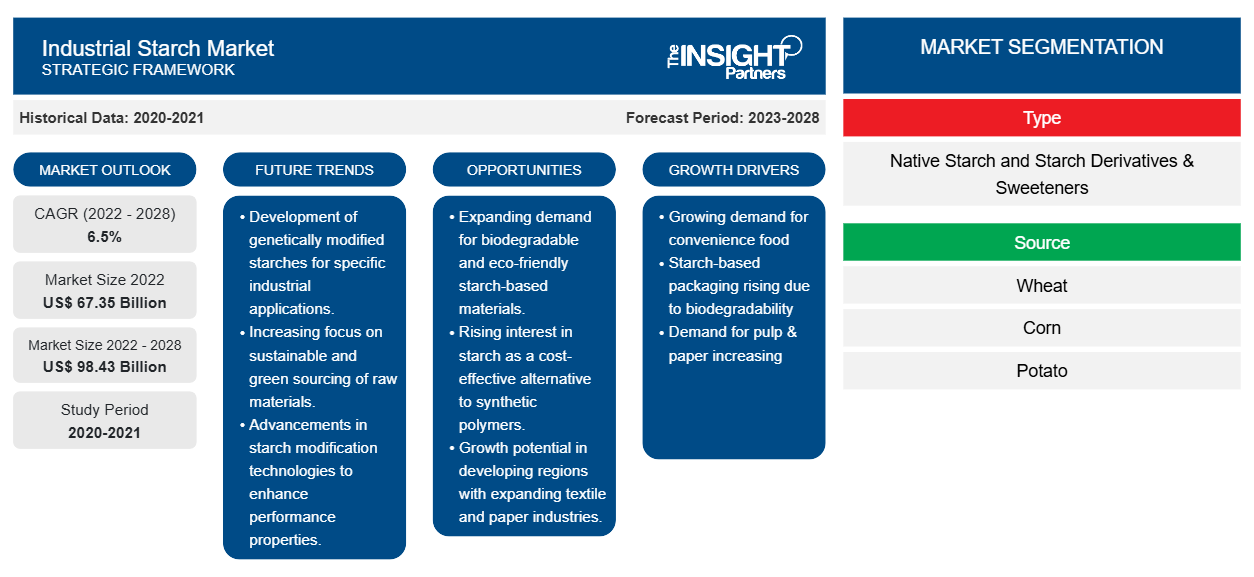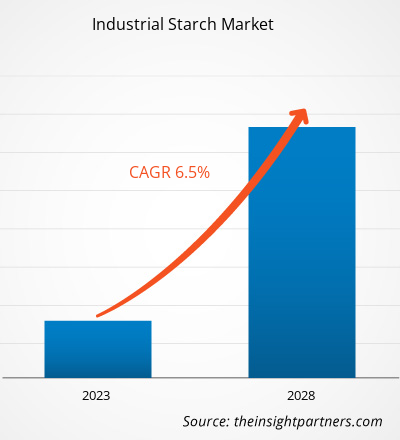[Forschungsbericht] Der Markt für industrielle Stärke soll von 67.353,01 Millionen US-Dollar im Jahr 2022 auf 98.426,74 Millionen US-Dollar im Jahr 2028 wachsen; von 2022 bis 2028 wird mit einer durchschnittlichen jährlichen Wachstumsrate von 6,5 % gerechnet.
Stärke ist ein komplexes Kohlenhydrat, das aus Weizen, Mais, Kartoffeln, Tapioka und Reis gewonnen wird. Sie ist eine großartige Energiequelle. Stärke ist ein Verdickungs-/Geliermittel und Stabilisator in einer Vielzahl von Lebensmitteln und Getränken, darunter Back- und Süßwaren, Suppen, Soßen, gefrorene Desserts, Milchcremes und Fertiggetränke. Die Nachfrage nach Fertiggerichten steigt weltweit aufgrund des hektischen Lebensstils der Verbraucher und des hohen Pro-Kopf-Einkommens. Darüber hinaus benötigen Lebensmittelverpackungen auf Papierbasis eine Beschichtung, um zu verhindern, dass Wasser oder Sauerstoff in die Verpackung eindringt und die Lebensmittel im Inneren verderben. Normalerweise wird diese Schutzbeschichtung aus Kunststoff auf Erdölbasis hergestellt. Hersteller verwenden jedoch biologisch basierte und umweltfreundliche Rohstoffe für die Beschichtung von Lebensmittelverpackungen auf Papierbasis, da ihnen die negativen Auswirkungen von Kunststoff auf Erdölbasis auf die Umwelt immer bewusster werden. Eigenschaften von Verpackungen auf Stärkebasis wie biologische Abbaubarkeit und Erschwinglichkeit steigern die Beliebtheit bei den Herstellern.
In den letzten Jahren ist die Nachfrage nach Stärke in der Zellstoff- und Papierindustrie mit der Ausweitung der Aktivitäten in dieser Branche erheblich gestiegen. Die boomende E-Commerce-Branche trägt erheblich zur Nachfrage nach Wellpappe bei. Darüber hinaus treibt ein deutlicher Trend hin zu kunststofffreien Verpackungen zur Gewährleistung der ökologischen Nachhaltigkeit die Nachfrage nach nachhaltigen Verpackungsmaterialien an. Laut einer von Roquette Frères durchgeführten Studie stieg der Verbrauch von Industriestärke bei der Herstellung von Wellpappe im Jahr 2020 um 6 %, was auf den deutlichen Anstieg des E-Commerce-Sektors im Zuge der COVID-19-Pandemie zurückzuführen ist. Die steigende Nachfrage nach Stärke in der Papier- und Kartonindustrie stärkt also den Markt für Industriestärke
Passen Sie diesen Bericht Ihren Anforderungen an
Sie erhalten kostenlose Anpassungen an jedem Bericht, einschließlich Teilen dieses Berichts oder einer Analyse auf Länderebene, eines Excel-Datenpakets sowie tolle Angebote und Rabatte für Start-ups und Universitäten.
- Holen Sie sich die wichtigsten Markttrends aus diesem Bericht.Dieses KOSTENLOSE Beispiel umfasst eine Datenanalyse von Markttrends bis hin zu Schätzungen und Prognosen.
Hersteller auf der ganzen Welt profitieren vom Wachstum der E-Commerce-Branche. Weltweit fördern verschiedene Hersteller und E-Commerce-Kanäle die Verwendung nachhaltiger und umweltfreundlicher Verpackungsmaterialien. Das Wachstum des Marktes für industrielle Stärke dürfte durch die zunehmende Verwendung nachhaltiger Verpackungsmaterialien durch die E-Commerce-Branche angekurbelt werden. Die indischen E-Commerce-Unternehmen Myntra und Flipkart haben beschlossen, die Verwendung von Einwegplastik in ihren Verpackungsmaterialien zu reduzieren oder ganz zu vermeiden. Darüber hinaus dürften staatliche Maßnahmen zur Reduzierung der Plastikverschmutzung die Nachfrage nach industrieller Stärke ankurbeln.benefitting from the growth of the e-commerce industry. Across the globe, various manufacturers and e-commerce channels are promoting the use of sustainable and eco-friendly packaging materials. The industrial starch market growth is expected to boost with this increasing adoption of Myntra and Flipkart have adopted to reduce or eliminate the use of single-use plastic in their packaging materials. Moreover, government policies to reduce plastic pollution is expected to boost the demand for industrial starch.
Markteinblicke
Breites Anwendungsspektrum von Industriestärke fördert Marktwachstum
Der Anwendungsbereich von Industriestärken in verschiedenen Endverbrauchsbranchen hat sich in den letzten Jahren erweitert. Sie wird als Verdickungs-, Gelier- und Bindemittel in einer Vielzahl von Lebensmitteln und Getränken verwendet, darunter Backwaren, Suppen und Salatdressings, Süßwaren, Soßen, Eiscreme , Fruchtgetränke und Milchprodukte. Stärke wird auch in Non-Food-Anwendungen wie Zellstoff und Papier, Pharmazeutika und Tierfutter verwendet. In der Pharmaindustrie wird Stärke als Hilfsstoff und Bindemittel bei der Herstellung von Tabletten verwendet. Darüber hinaus sind stärkebasierte Materialien eine perfekte Lösung für biologisch abbaubare Lebensmittelverpackungsmaterialien, die zur Reduzierung der Umweltverschmutzung beitragen.excipient and binding agent in tablet making. Moreover, starch-based materials are a perfect solution for biodegradable food packaging materials that help to reduce environmental pollution.
Typ-Einblicke
Basierend auf dem Typ ist der Markt für industrielle Stärke in native Stärke und Stärkederivate sowie Süßstoffe unterteilt. Im Jahr 2021 dominierte das Segment der Stärkederivate und Süßstoffe den Markt. Die wachsende Nachfrage nach Lebensmitteln und Getränken aufgrund des Anstiegs des verfügbaren Einkommens und der wachsenden Weltbevölkerung sowie die Verwendung von Stärkederivaten in der Lebensmittel- und Getränkeindustrie sind der wichtigste Wachstumstreiber für das Segment der Stärkederivate des Marktes für industrielle Stärke.
Zu den wichtigsten Akteuren auf dem Markt für industrielle Stärke zählen Agrana Beteiligungs-AG, ADM, Ingredion Incorporated, Roquette Frères, Tereos Group, Cargill, Incorporated, Tate & Lyle PLC, Grain Processing Corporation, Royal Cosun und AVEBE. Die führenden Akteure verfolgen verschiedene Strategien, wie Fusionen und Übernahmen sowie Produkteinführungen, um ihre geografische Präsenz und Kundenbasis zu erweitern. Beteiligungs-AG; ADM; Ingredion Incorporated; Roquette Frères; Tereos Group; Cargill, Incorporated; Tate & Lyle PLC; Grain Processing Corporation; Royal Cosun; and AVEBE are among the key players operating in the industrial starch market. The leading players adopt several strategies, such as mergers & acquisitions and product launches, to expand their geographic presence and consumer base.
Bericht-Spotlights
- Progressive Trends in der industriellen Stärkeindustrie helfen den Akteuren bei der Entwicklung wirksamer langfristiger Strategien
- Von Unternehmen verfolgte Geschäftswachstumsstrategien zur Sicherung des Wachstums in entwickelten und sich entwickelnden Märkten
- Quantitative Analyse des globalen Marktes für industrielle Stärke von 2021 bis 2028
- Schätzung der Nachfrage nach Industriestärke in verschiedenen Branchen
- Porters Fünf-Kräfte-Analyse zur Veranschaulichung der Wirksamkeit von Käufern und Lieferanten in der industriellen Stärkeindustrie
- Aktuelle Entwicklungen zum Verständnis des Wettbewerbsmarktszenarios und der Nachfrage nach Industriestärke
- Markttrends und -aussichten in Verbindung mit Faktoren, die das Wachstum des Marktes für industrielle Stärke bestimmen
- Verständnis für die Strategien, die das kommerzielle Interesse im Hinblick auf das Marktwachstum untermauern, als Unterstützung im Entscheidungsprozess
- Größe des Industriestärkemarktes an verschiedenen Marktknoten
- Detaillierte Übersicht und Segmentierung des Marktes sowie seiner Branchendynamik
- Größe des Industriestärkemarktes in verschiedenen Regionen mit vielversprechenden Wachstumschancen
Regionale Einblicke in den Markt für industrielle Stärke
Die regionalen Trends und Faktoren, die den Markt für industrielle Stärke im Prognosezeitraum beeinflussen, wurden von den Analysten von Insight Partners ausführlich erläutert. In diesem Abschnitt werden auch die Marktsegmente und die Geografie für industrielle Stärke in Nordamerika, Europa, im asiatisch-pazifischen Raum, im Nahen Osten und Afrika sowie in Süd- und Mittelamerika erörtert.

- Erhalten Sie regionalspezifische Daten zum Markt für industrielle Stärke
Umfang des Marktberichts für industrielle Stärke
| Berichtsattribut | Details |
|---|---|
| Marktgröße im Jahr 2022 | 67,35 Milliarden US-Dollar |
| Marktgröße bis 2028 | 98,43 Milliarden US-Dollar |
| Globale CAGR (2022 - 2028) | 6,5 % |
| Historische Daten | 2020-2021 |
| Prognosezeitraum | 2023–2028 |
| Abgedeckte Segmente | Nach Typ
|
| Abgedeckte Regionen und Länder | Nordamerika
|
| Marktführer und wichtige Unternehmensprofile |
|
Dichte der Akteure auf dem Markt für industrielle Stärke: Die Auswirkungen auf die Geschäftsdynamik verstehen
Der Markt für Industriestärke wächst rasant, angetrieben durch die steigende Nachfrage der Endverbraucher aufgrund von Faktoren wie sich entwickelnden Verbraucherpräferenzen, technologischen Fortschritten und einem größeren Bewusstsein für die Vorteile des Produkts. Mit steigender Nachfrage erweitern Unternehmen ihr Angebot, entwickeln Innovationen, um die Bedürfnisse der Verbraucher zu erfüllen, und nutzen neue Trends, was das Marktwachstum weiter ankurbelt.
Die Marktteilnehmerdichte bezieht sich auf die Verteilung der Firmen oder Unternehmen, die in einem bestimmten Markt oder einer bestimmten Branche tätig sind. Sie gibt an, wie viele Wettbewerber (Marktteilnehmer) in einem bestimmten Marktraum im Verhältnis zu seiner Größe oder seinem gesamten Marktwert präsent sind.
Die wichtigsten auf dem Markt für industrielle Stärke tätigen Unternehmen sind:
- AGRANA Beteiligungs-AG
- ADM
- Ingredion Incorporated
- Roquette Frères
- Tereos-Gruppe
Haftungsausschluss : Die oben aufgeführten Unternehmen sind nicht in einer bestimmten Reihenfolge aufgeführt.

- Überblick über die wichtigsten Akteure auf dem Markt für industrielle Stärke
Die „Marktanalyse für industrielle Stärke bis 2028“ ist eine spezialisierte und eingehende Studie der Chemie- und Materialindustrie, die sich auf die Markttrendanalyse konzentriert. Der Bericht soll einen Überblick über den Markt mit detaillierter Segmentierung geben. Der Markt für industrielle Stärke ist nach Typ, Quelle, Anwendung und Geografie segmentiert. Basierend auf dem Typ ist der Markt für industrielle Stärke in native Stärke und Stärkederivate und Süßstoffe segmentiert. Basierend auf der Quelle ist der Markt in Weizen, Mais, Kartoffeln, Maniok und andere segmentiert. Basierend auf der Anwendung ist der Markt in Lebensmittel und Getränke, Zellstoff und Papier, Tierfutter, Pharmazeutika und andere segmentiert. Basierend auf der Geografie ist der Markt in fünf Hauptregionen segmentiert: Nordamerika, Europa, Asien-Pazifik, Naher Osten und Afrika sowie Süd- und Mittelamerika. Im Jahr 2021 dominierte der Asien-Pazifik-Raum den Markt für industrielle Stärke.
- Historische Analyse (2 Jahre), Basisjahr, Prognose (7 Jahre) mit CAGR
- PEST- und SWOT-Analyse
- Marktgröße Wert/Volumen – Global, Regional, Land
- Branche und Wettbewerbsumfeld
- Excel-Datensatz



Report Coverage
Revenue forecast, Company Analysis, Industry landscape, Growth factors, and Trends

Segment Covered
This text is related
to segments covered.

Regional Scope
North America, Europe, Asia Pacific, Middle East & Africa, South & Central America

Country Scope
This text is related
to country scope.
Häufig gestellte Fragen
Growth in the global food and beverage industry and an increase in demand from the packaging industry are drivers of the industrial starch market. The growing population around the world is increasing the demand for the food and beverages industrial starch market. And the significant growth of e-commerce and increasing adoption of eco-friendly packaging material is expected to propel the demand for industrial starch.
The major players operating in the global industrial starch market is AGRANA Beteiligungs-AG; ADM; Ingredion Incorporated.; Roquette Frères; Tereos Group; Cargill, Incorporated Tate & Lyle PLC; Grain Processing Corporation; Royal Cosun; AVEBE.
In 2021, North America accounted for the highest growth of the global industrial starch market. Starch is used as a thickening/gelling agent and stabilizer in a wide range of food and beverages, including bakery and confectionery products, soups, sauces, frozen desserts, dairy creamers, and ready-to-drink beverages. The rising demand for convenience food owing to the hectic lifestyle and high per-capita income of consumers is driving the demand for starch in the food & beverages industry. Veganism and clean-label trends are surging rapidly across the world.
Product innovation in industrial starches is a recent trend in the global industrial starch market. There is a strong demand for products with organic, clean-label, and plant-based ingredients in Europe owing to rising health and wellness concerns. This clean-label product provides instant viscosity, thereby enabling optimal control of rheological behavior in cake mixes, sauces, or other semiliquid formulations. It can also be used to prepare high-quality savory products, pastries, and fruit-based fillings to provide a premium look and texture.
Based on the application pulp and paper segment is leading the market in 2021. As there is a high demand for starch from the papermaking industry in the region due to the rising demand for paper products from the packaging and transportation industries. The booming e-commerce industry in the region is also generating demand for corrugated paper and paperboards, thereby contributing to the industrial starch market progress
Based on the segment type, starch derivatives and sweeteners were the fastest-growing segment in 2021. Starch derivatives and sweeteners are obtained from the further processing of native starch. Usually, native starch is converted into glucose syrup, which is processed to obtain maltodextrins, isoglucose, polyols, and dextrose
Trends and growth analysis reports related to Food and Beverages : READ MORE..
The List of Companies - Industrial Starch Market
- AGRANA Beteiligungs-AG
- ADM
- Ingredion Incorporated
- Roquette Frères
- Tereos Group
- Cargill, Incorporated.
- Tate & Lyle PLC
- Grain Processing Corporation
- Royal Cosun
- AVEBE
The Insight Partners performs research in 4 major stages: Data Collection & Secondary Research, Primary Research, Data Analysis and Data Triangulation & Final Review.
- Data Collection and Secondary Research:
As a market research and consulting firm operating from a decade, we have published and advised several client across the globe. First step for any study will start with an assessment of currently available data and insights from existing reports. Further, historical and current market information is collected from Investor Presentations, Annual Reports, SEC Filings, etc., and other information related to company’s performance and market positioning are gathered from Paid Databases (Factiva, Hoovers, and Reuters) and various other publications available in public domain.
Several associations trade associates, technical forums, institutes, societies and organization are accessed to gain technical as well as market related insights through their publications such as research papers, blogs and press releases related to the studies are referred to get cues about the market. Further, white papers, journals, magazines, and other news articles published in last 3 years are scrutinized and analyzed to understand the current market trends.
- Primary Research:
The primarily interview analysis comprise of data obtained from industry participants interview and answers to survey questions gathered by in-house primary team.
For primary research, interviews are conducted with industry experts/CEOs/Marketing Managers/VPs/Subject Matter Experts from both demand and supply side to get a 360-degree view of the market. The primary team conducts several interviews based on the complexity of the markets to understand the various market trends and dynamics which makes research more credible and precise.
A typical research interview fulfils the following functions:
- Provides first-hand information on the market size, market trends, growth trends, competitive landscape, and outlook
- Validates and strengthens in-house secondary research findings
- Develops the analysis team’s expertise and market understanding
Primary research involves email interactions and telephone interviews for each market, category, segment, and sub-segment across geographies. The participants who typically take part in such a process include, but are not limited to:
- Industry participants: VPs, business development managers, market intelligence managers and national sales managers
- Outside experts: Valuation experts, research analysts and key opinion leaders specializing in the electronics and semiconductor industry.
Below is the breakup of our primary respondents by company, designation, and region:

Once we receive the confirmation from primary research sources or primary respondents, we finalize the base year market estimation and forecast the data as per the macroeconomic and microeconomic factors assessed during data collection.
- Data Analysis:
Once data is validated through both secondary as well as primary respondents, we finalize the market estimations by hypothesis formulation and factor analysis at regional and country level.
- Macro-Economic Factor Analysis:
We analyse macroeconomic indicators such the gross domestic product (GDP), increase in the demand for goods and services across industries, technological advancement, regional economic growth, governmental policies, the influence of COVID-19, PEST analysis, and other aspects. This analysis aids in setting benchmarks for various nations/regions and approximating market splits. Additionally, the general trend of the aforementioned components aid in determining the market's development possibilities.
- Country Level Data:
Various factors that are especially aligned to the country are taken into account to determine the market size for a certain area and country, including the presence of vendors, such as headquarters and offices, the country's GDP, demand patterns, and industry growth. To comprehend the market dynamics for the nation, a number of growth variables, inhibitors, application areas, and current market trends are researched. The aforementioned elements aid in determining the country's overall market's growth potential.
- Company Profile:
The “Table of Contents” is formulated by listing and analyzing more than 25 - 30 companies operating in the market ecosystem across geographies. However, we profile only 10 companies as a standard practice in our syndicate reports. These 10 companies comprise leading, emerging, and regional players. Nonetheless, our analysis is not restricted to the 10 listed companies, we also analyze other companies present in the market to develop a holistic view and understand the prevailing trends. The “Company Profiles” section in the report covers key facts, business description, products & services, financial information, SWOT analysis, and key developments. The financial information presented is extracted from the annual reports and official documents of the publicly listed companies. Upon collecting the information for the sections of respective companies, we verify them via various primary sources and then compile the data in respective company profiles. The company level information helps us in deriving the base number as well as in forecasting the market size.
- Developing Base Number:
Aggregation of sales statistics (2020-2022) and macro-economic factor, and other secondary and primary research insights are utilized to arrive at base number and related market shares for 2022. The data gaps are identified in this step and relevant market data is analyzed, collected from paid primary interviews or databases. On finalizing the base year market size, forecasts are developed on the basis of macro-economic, industry and market growth factors and company level analysis.
- Data Triangulation and Final Review:
The market findings and base year market size calculations are validated from supply as well as demand side. Demand side validations are based on macro-economic factor analysis and benchmarks for respective regions and countries. In case of supply side validations, revenues of major companies are estimated (in case not available) based on industry benchmark, approximate number of employees, product portfolio, and primary interviews revenues are gathered. Further revenue from target product/service segment is assessed to avoid overshooting of market statistics. In case of heavy deviations between supply and demand side values, all thes steps are repeated to achieve synchronization.
We follow an iterative model, wherein we share our research findings with Subject Matter Experts (SME’s) and Key Opinion Leaders (KOLs) until consensus view of the market is not formulated – this model negates any drastic deviation in the opinions of experts. Only validated and universally acceptable research findings are quoted in our reports.
We have important check points that we use to validate our research findings – which we call – data triangulation, where we validate the information, we generate from secondary sources with primary interviews and then we re-validate with our internal data bases and Subject matter experts. This comprehensive model enables us to deliver high quality, reliable data in shortest possible time.


 Holen Sie sich ein kostenloses Muster für diesen Bericht
Holen Sie sich ein kostenloses Muster für diesen Bericht